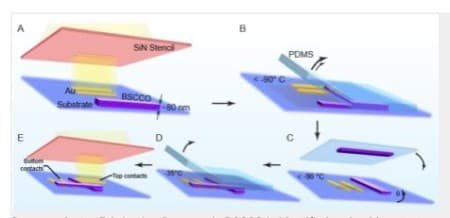An international team that includes Rutgers University-New Brunswick scientists has developed a new method to make and manipulate a widely studied class of high-temperature superconductors. This technique should pave the way for the creation of unusual forms of superconductivity in previously unattainable materials.
The article reporting the new work has been published in Science.
When cooled to a critical temperature, superconductors can conduct electricity without resistance or energy loss. These materials have intrigued physicists for decades because they can achieve a state of perfect conductivity allowing an electric current to flow indefinitely. But most superconductors only exhibit this peculiarity at temperatures so low – a few degrees above absolute zero – which renders them impractical.
The report describes experiments that grew out of theoretical calculations that included those by a Rutgers team led by Jedediah Pixley, a condensed matter theorist and an associate professor in the Department of Physics and Astronomy in the Rutgers School of Arts and Sciences.
The experiments confirmed predictions by Pixley and Pavel Volkov, who at the time was a postdoctoral fellow at the Rutgers Center for Materials Theory. These predictions, based on mathematical models Pixley and Volkov (now at the University of Connecticut) devised to represent the underlying quantum physical behavior, projected how cuprate superconductors would behave if they were placed in proximity in specific configurations and at varying angles.

Superconductor Fabrication Process. A. BSCCO is identified and gold contacts pre-evaporated next to it. B. Cold PDMS is quickly pulled away, cleaving the crystal. C. Substrate is quickly rotated by θ, and top crystal is quickly re-assembled with the bottom. D. Assembly is warmed to -35° C, and PDMS slowly removed. E. Top contacts on bottom crystal deposited. Image Credit: Rutgers University. For more info the reporting paper is behind a paywall. However much can be learned from the supplemental materials available at this link.
Superconductors are already in use today. Since the 1970s, scientists have employed superconducting magnets to generate the powerful magnetic fields needed for the operation of magnetic resonance imaging (MRI) machines. Maglev trains using the technology were introduced in the 1980s. More recently, scientists have harnessed the power of superconducting magnets to guide electron beams in experimental devices such as synchrotrons and accelerators.
In the future, scientists envision a world where ultra-efficient electricity grids, ultrafast and energy-efficient computer chips, and even quantum computers are powered by new kinds of superconducting materials.
The new experiments that validated Pixley’s and Volkov’s ideas were conducted by a team at Harvard University led by professor and physicist Philip Kim.
Pixley explained, “We took two cuprate superconductors – materials that already were interesting – and, in placing them together and twisting them in a precise way, made something else that was very interesting: another superconductor which could have lots of technological applications.”
Because of its unique properties, the new superconductor is a promising candidate for the world’s first high-temperature, superconducting diode, essentially a switch that controls the flow of electrical current, the researchers said.
Such a device could potentially fuel fledgling industries such as quantum computing, which rely on fleeting phenomena produced in materials like superconductors, they added.
Pixley, who joined the Rutgers faculty in 2017, earned his doctoral degree by studying the conditions involved in producing superconductivity in unconventional materials. The latest research extends the field of “twistronics,” which involves twisting flat layers of two-dimensional materials to produce physical effects at the subatomic level that are observable on the macroscopic scale.
To Pixley, the study enlarges the paradigm of what materials can exhibit superconducting properties when twisted. The work yields other insights, as well. “At the same time, we have found that this leads to a novel type of ‘magnetic’ superconducting state that has been long sought after, showing definitively that different superconducting phases can be reached via a twist,” he said.
The experimentalists first split an extremely thin film of a superconductive cuprate – nicknamed “BSCCO” and made of bismuth strontium calcium copper oxide – into two layers. Then, maintaining frigid conditions, they stacked the layers at a 45-degree twist, like an ice cream sandwich with askew wafers, retaining superconductivity at the fragile interface.
Cuprates are copper oxides that, decades ago, upended the physics world by showing they become superconducting at much higher temperatures than theorists had thought possible. BSCCO is considered a high-temperature superconductor because it starts superconducting at about -288 Fahrenheit. That is very cold by practical standards, but astonishingly high among classical superconductors, which typically must be cooled to about -400 Fahrenheit.
The work opens the door to more experiments, Pixley said.
“It will be very exciting to extend these experiments to other configurations of superconductors – twisted monolayers and a few twisted multilayers of superconductors at small twist angles,” Pixley said.
Other researchers on the study included scientists from the University of British Columbia, Brookhaven National Laboratory, the Leibniz Institute for Solid State and Materials Research in Germany, Seoul National University in South Korea and the National Institute for Materials Science in Japan.
**
Perhaps the superconductor effort is going to get practical. Minus 288º F is more than one hundred degrees Fahrenheit closer to practical. Maybe 250 degrees warmer would do the trick. It would certainly get closer to practical refrigeration. Getting to about a minus 30º F is way less expensive in equipment and energy than trying to get to -288º.
The big news is that the innovation in construction has made quite a leap forward. Now there are two ideas to research, the materials and the build design. One is inclined to think superconductivity will get practical someday.
By Brian Westenhaus via New Energy and Fuel
More Top Reads From Oilprice.com:
- European Commission Downgrades Growth Forecast for 2024
- Climate vs. Commerce: Inside the Debate Over U.S. LNG Expansion
- 10 Reasons Why the World Can’t Run Without Fossil Fuels


















